Guest blogger: Marie Nolan
Early life
Annie Cuskelly was born in the family home at “Happy Valley” later absorbed into the nearby town of Aubigny on the Darling Downs in south-east Queensland. She was the sixth child of Irish migrants who had met and married in Queensland Though not the eldest daughter she was given her mother’s name. The family of seven boys and six girls grew up harmoniously and their life-long friendship has continued down through the generations. While the young men turned to maintaining the dairy farm the girls looked for work to help the family. Annie found her vocation in nursing.

Her initial training was at a private hospital in Toowoomba and when she moved on it was to be the attending nurse for one of the city’s established doctors in his private practice. When she decided to enlist early in 1915 she sought and was granted a certificate in nursing by the Toowoomba General Hospital. A formal certificate was required by the Australian Army Nursing Service.

Staff at Kangaroo Point Military Hospital, WWI
Initially she was stationed at the 6th Australian General Hospital, Kangaroo Point, Brisbane where she met George Martin. They married in 1919. Members of AANS were required to provide their own uniform and effects; so much of her initial time in Brisbane would have been taken up with acquiring these. The firm of “Finney Isles” was known to be the store to outfit the nurses. A cabin trunk was also required and a carry-all. This would have been quite an outlay for her.
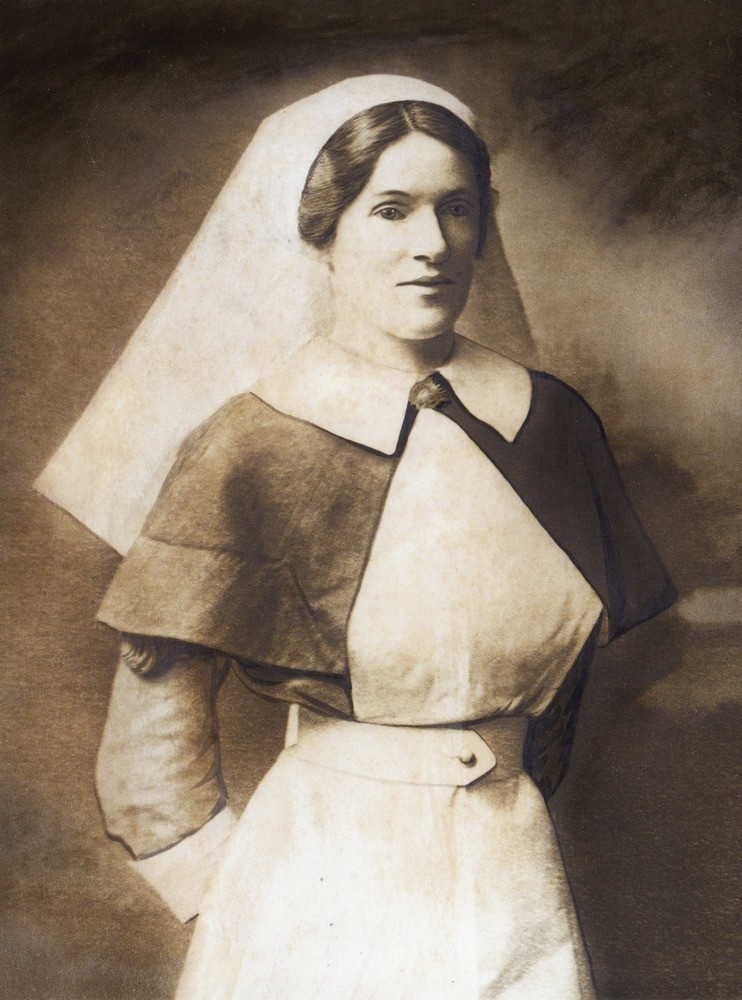
Annie Cuskelly after enlistment
She moved on then to New South Wales, to the 4th Australian General Hospital & Casino Camp Hospital based at the Show Grounds. Her enlistment dates from August 1915 but it was at the end of 1916 that she embarked on the troop ship “Themistocles”, bound for Plymouth, arriving in March 1917.
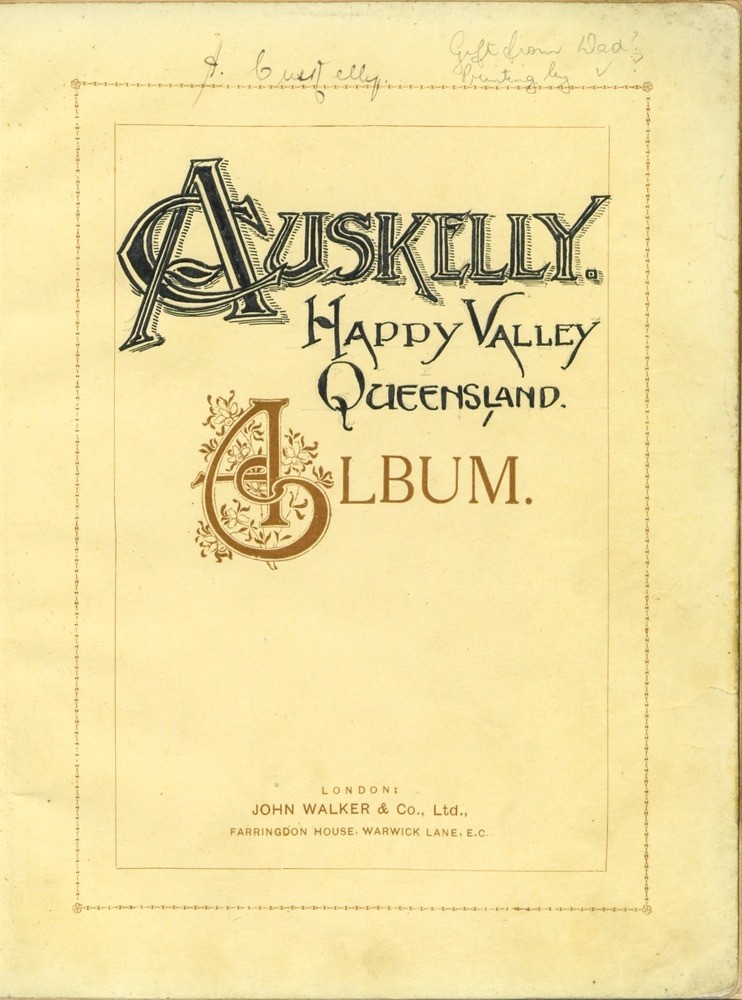
Sister Annie Cuskelly's Autograph book. Covers Annie's voyage on the Themistocles, her active service in France and England, and the voyage home on the Orontes. Contains handwritten text and a variety of hand drawn or painted illustrations.
Active Service
Within days of arrival at Plymouth she was posted to 7th General Hospital France. Annie’s service records as supplied are fairly cursory, and material recording the service of the nurses would suggest that their presence and availability was considered more important than detailed records. Army Form B 103, on which such details as are available are shown, is actually designed to record the casualty history of individual soldiers.

Autographs of people Annie met on the Themistocles, February 1917
While Annie reached France in March 1917 it was many months before any more specific location is given. After a time at a Casualty Clearing Station, she was transferred to Nurses’ Home in Boulogne. By then the terrible battle of the Somme was past and the Germans had retreated to the Hindenburg line where the effort continued for days and on different fronts. There were other postings to Casualty Clearing Stations. Annie did tell us that at times she was nursing within ear shot of “Big Bertha”. The nickname applies to a heavy mortar which the German army could move to various locations.
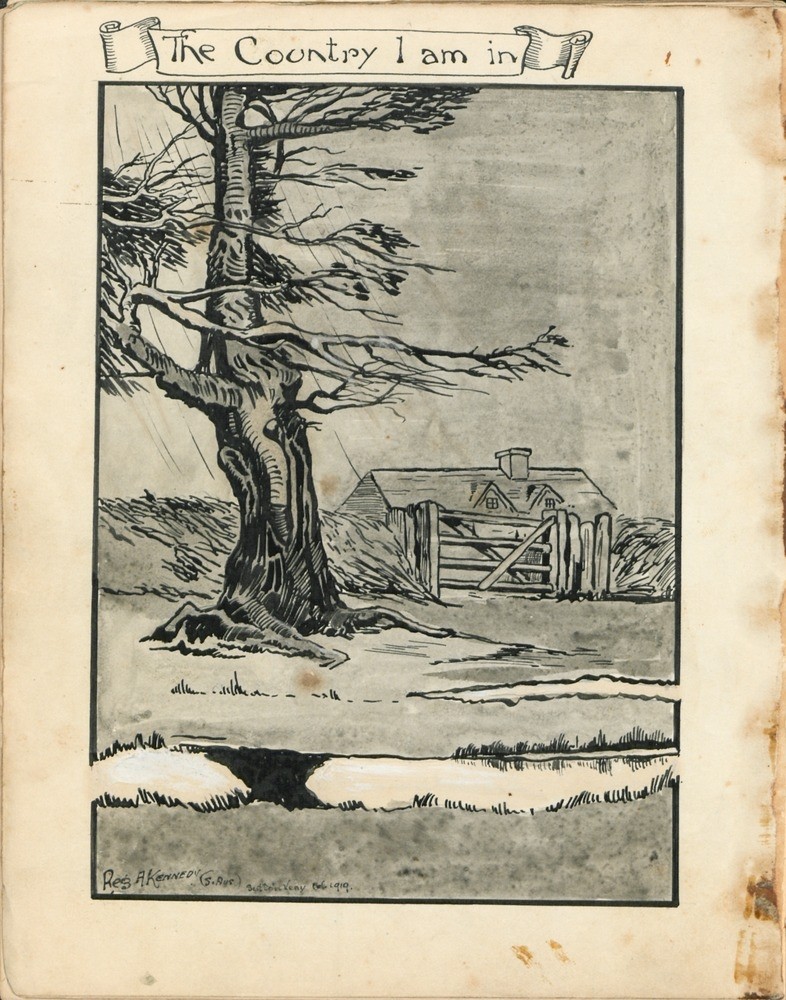
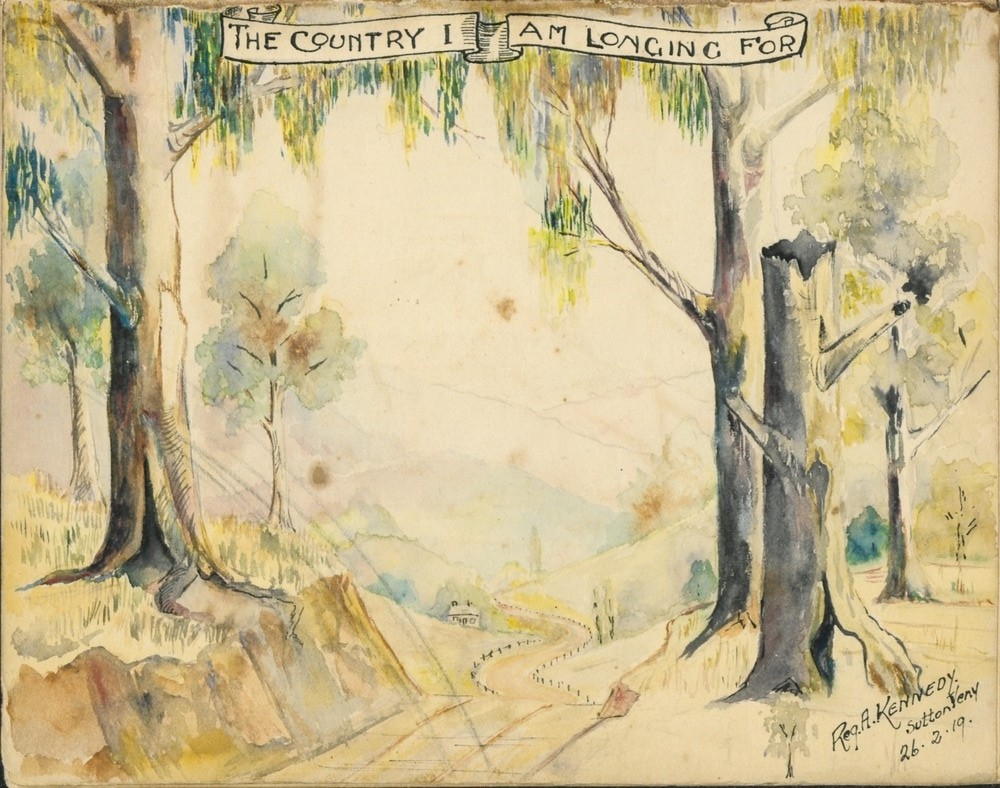
Illustration - 'The Country I am longing for' by Reg. A. Kennedy
Once in active service, she was touched by the youth of the servicemen she saw. The memory was so painful that it was one of the few things she repeated. “They would come over from England, go up to the front line, be injured, be brought in for treatment, returned to England, if necessary - all within a week and not yet 18”. She also said that for some “we would give them morphine, and put “M” in blue on their forehead”. Presuming she was living in the Nurses’ Home on 29 September, at least that ought to have been a reasonably congenial atmosphere for her to “celebrate” her 30th birthday.

Interior of the Acute Surgical Ward at the 3rd Australian General Hospital. Australian War Memorial, E02605
At the end of 1917 she reported to the 3rd Australian General Hospital and it is apparent from the first hand accounts in diaries kept by the nurses that they valued being able to work together. For young women coming from the informal way of life they had known in Australia, the disciplines of the English Army Nursing Service were not a comfortable fit. From then on, in places like Abbeville, Dieppe, St.Omer and Rouen I believe she was working with her compatriots.

The Sisters' Mess Room at the 3rd Australian General Hospital at Abbeville, Australian War Memorial, E02755
Annie brought home with her spoons she bought in various places she was stationed, such as mentioned above. In Dunkirk - yet to assume its place in history - she did not find a spoon so bought sugar tongs instead.
A short respite
It was only in the final months of World War 1 that Annie was granted leave and she spent it in England. It is probable that she was not alone as any of the few stories she told were about what “we” did. One of the nurses she shared escapades with was “Toftie”. Nurse Toft was a Salvation Army member and my mother spoke with admiration of “those girls”. There were three Tofts in the AANS and two were sisters so perhaps it was those two with whom Annie nursed. With “Toftie” being a member of the Salvation Arrmy it would seem that she tried to keep in touch with this body when possible, presumably in England. We remember her saying that she had told her friend, “I’ll go to church with you Toftie, but I’m not standing on a street corner shaking a tambourine!” It seems they had fun together but London’s Underground defeated them. Each time they alighted and went up to street level they found themselves at Trafalgar Square. “Toftie” in frustration is said to have threatened, “If you lions don’t stop laughing at me, I’ll ‘frow’ mud at you”. Once on street level the traffic was daunting. The traffic islands were, to these girls, “glory be to Gods” as that was how they felt when they got safely that far.
That leave was in late Autumn and to girls from Queensland the low temperatures were hard to endure. Their solution for part of the time was to purchase a return rail ticket to and from Scotland, because the carriages were heated. Annie spoke of nursing in that terrible winter when everything froze even the liquid medications and the ink for writing. Raw eggs had to be sawed open; blankets froze when hot water bottles split. Their shelters, as we know, were canvas.

Staff of the 1AGH, Sutton Veny, share a joke with Prime Minister Hughes, 1919. Australian War Memorial P02402.031
Peace
Refreshed by that leave Annie returned to duty and the day came that hostilities ended. She told us that she was in Paris when the armistice was signed. It was after the Armistice, that No. 1 Australian General Hospital was transferred to Sutton Veny where it remained until the end of 1919. That provided satisfaction to the Australian Nurses to be looking after Australian Servicemen in their own hospital. It was just before Christmas that she arrived and was promoted to Sister. For the Australian nurses rank was not considered a priority. For one thing it prohibited fraternisation with lower ranks and in some cases that applied to their own family members.
While their duty was still the care and comfort of their patients, the nurses no doubt were more light hearted in general. I understand they held a garden party, perhaps to celebrate the arrival of Spring.
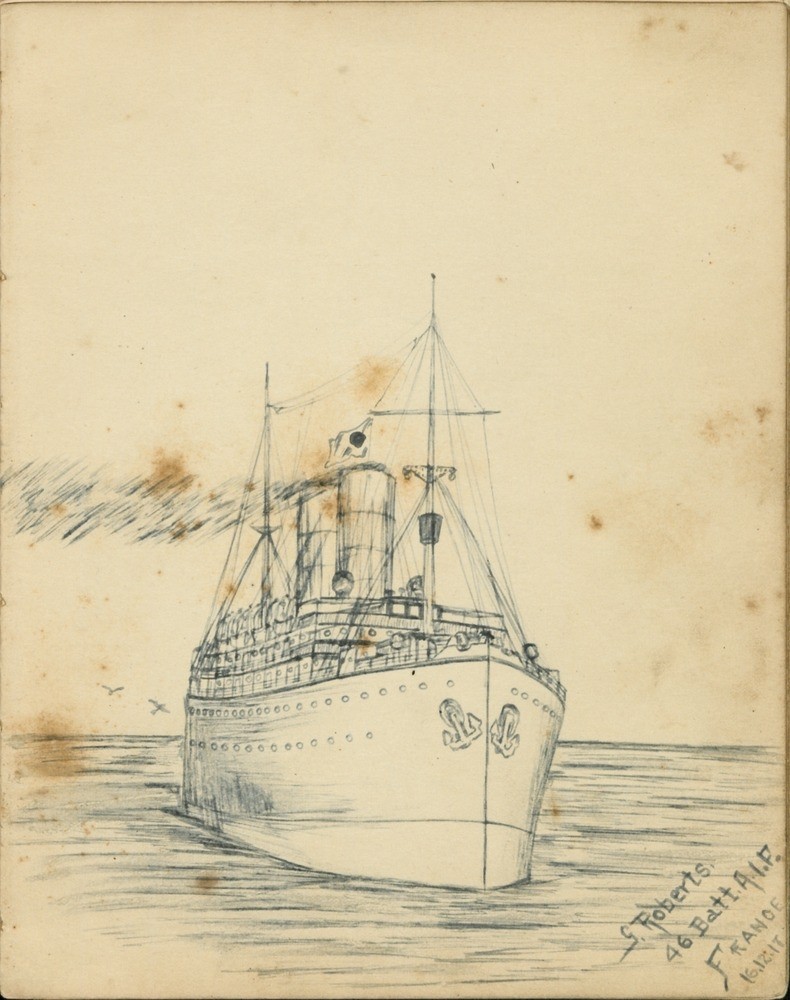
Illustration - ship, by George H. Roberts
Repatriation
Annie left England in May, 1919 - a passenger on “Orontes” bound for Sydney. She disembarked on 1st July. According to family history, in the interval between then and discharge on 9 August 1919 she was acting Matron at “Rosemount”. Originally a home to several notable Brisbane identities, the site was transformed into a military hospital during World War I and later served as a repatriation hospital, psychiatric facility and as a centre for rehabilitation.
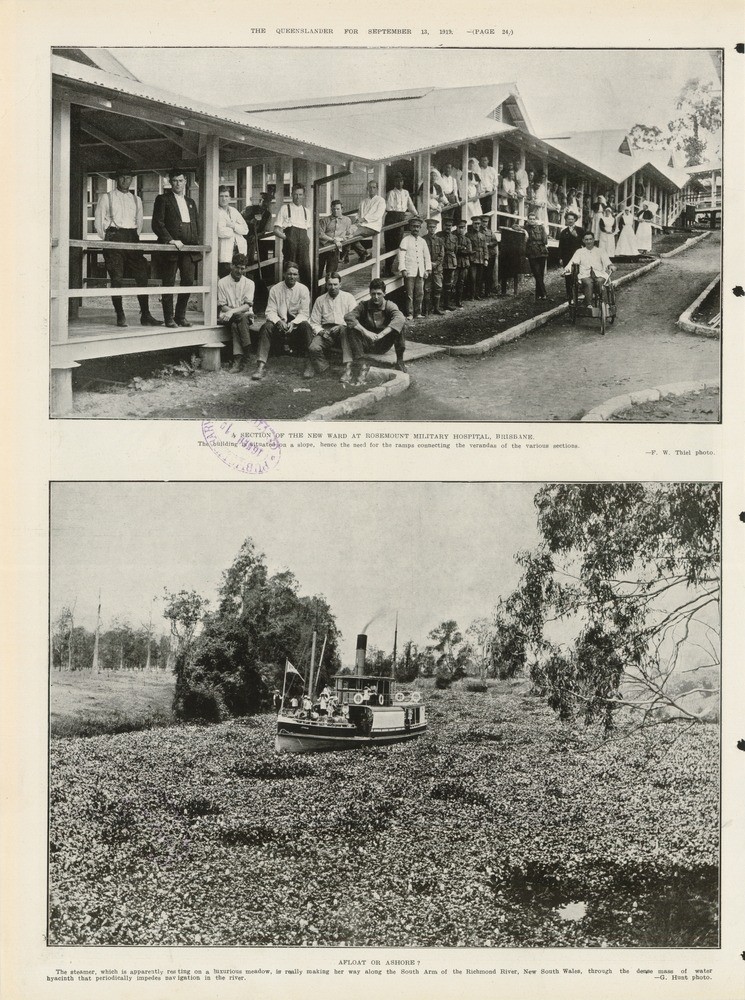
Rosemount Military Hospital in the Queenslander Pictorial supplement 13 September 1919
My parents’ wedding photo shows them both in uniform which tells me that they married soon after her return to Brisbane and before her discharge.

Annie Cuskelly and George Martin on their wedding day
Civilian life
Typical of service men and women, Annie did not speak much about her experiences of those years. She married and became a mother. It was a source of pride to her that it was her war service that helped finance the purchase of their home. As long as she was able she attended Anzac Day marches in Brisbane, wearing initially her service badge and later a badge which showed she was the mother of a member of the services in WW2. She told us that sometimes one of the old diggers would recognise that she was a returned nurse from WW1 and would greet her “Oh, Sister!!”
Soon after 1940 her eldest child and only son, the apple of his parents’ eyes, had enlisted in the RAAF and was very soon serving as a bomber pilot seconded to the RAF. As well, several loved nephews were serving in other theatres of war. It would be only human for her to block recollections of what she had seen.
Annie was, albeit informally, a nurse all her life. She inspired three nieces and a granddaughter to emulate her. In those hard years of the 30’s and the 40’s people of the working class suburb where she lived knew there was a nurse at our address and it was not unknown for a stranger to arrive at our home seeking help for a sick person. She never refused those requests.
She was a friendly person but her friendship was not given lightly. Once formed, it was for good. One of those friends was Charlotte, to whom she was close right to the end. They watched each other’s children grow and prosper. It so happened that at the end of their days they were in the same ward of a palliative care hospital. Charlotte was confined to her bed but Annie was mobile with the help of a wheel chair. She was able to go and sit beside Charlotte’s bed and would enjoy the company of the families as they visited. The time came one evening when it was apparent to her that Charlotte’s condition was declining. Annie suggested that the daughter then present leave and gather up the remainder of the family. It was 11p.m. by the time the group returned. They exclaimed in surprise to find Annie awake and still with Charlotte. “Oh,” said Annie, “ I couldn’t leave her!” The veteran nurse made sure the patient would not die alone.
When Rupert Goodman’s book Queensland Nurses: Boer War to Vietnam was launched in 1985, she was guest of honour. She was then the oldest surviving member of AANS in Queensland.
My mother, Annie Martin (nee Cuskelly) died 2 years later, aged 99 years and 9 months. She may well then have been the oldest surviving member of AANS.
Comments
Your email address will not be published.
We welcome relevant, respectful comments.